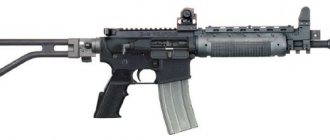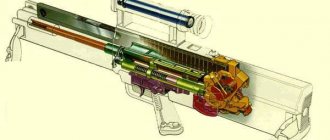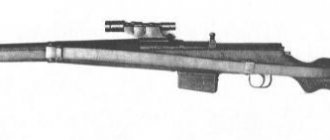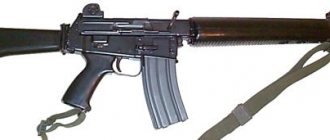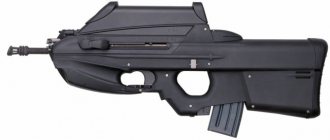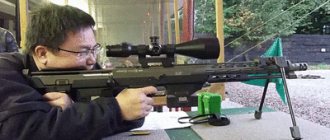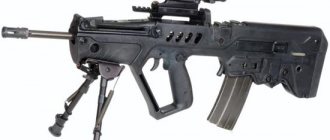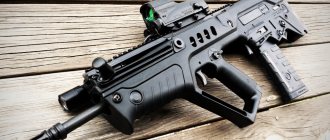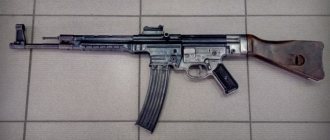Squad Type Automatic Weapon Automatic Rifle Assault Rifle Marker Rifle
| M27 Infantry Automatic Rifle | |
| US Marine armed with M27 IAR with ACOG Squad Day Optic | |
| Type | Squad Automatic Weapon Automatic Rifle Assault Rifle Marketing Rifle |
| Place of origin | Germany, USA |
| Service history | |
| In service | 2010–present |
| Used | US Marine Corps |
| Wars | Operation Enduring Freedom |
| Production history | |
| Designer | Heckler and Koch |
| Designed by | 2008 |
| Manufacturer | Heckler and Koch |
| Unit cost | US$1300 [1] |
| Produced | 2010–present |
| No. built | 14 100 [2] |
| Characteristics | |
| Weight | 7.9 lb (3.6 kg) unladen 9.8 lb (4.4 kg) loaded with sling [3] |
| Length | 36.9 to 33 inches (940 to 840 mm) with adjustable stock |
| Barrel length | 16.5 inches (420 mm) |
| Width | 3.1 inches (79 mm) |
| Height | 9.4 inches (240 mm) |
| Cartridge | 5.56×45mm NATO |
| Action | Gas short stroke piston, butterfly valve |
| Rate of fire | Sustained: 36 rounds/min Cyclic: 700–850 rounds/min |
| Effective firing range | 600 m (point target) 800 m (area target) [4] |
| Maximum firing range | 3,938 yards (3,601 m) [4] |
| Feeding system | STANAG magazine for 30 rounds |
| Attractions | 3.5 × Squad Day Optic, flip-up rear rotating diopter sight and front rack |
M27 Infantry Automatic Rifle
(
IAR
) is a lightweight magazine-fed 5.56 select fire weapon based on the HK416 rifle designed and manufactured by the German company Heckler & Koch. It is used by the United States Marine Corps (USMC) and is designed to improve the maneuverability of the automatic rifleman. The USMC originally planned to purchase 6,500 M27s to replace some of the M249 light machine guns used by automatic riflemen in the infantry and light armored reconnaissance battalions. Approximately 8,000–10,000 M249s will remain in Marine Corps service and will be used at the discretion of company commanders. In December 2022, the Marine Corps announced it would equip every member of its infantry squad with the M27. [5]
Last news
07/20/2019 10:44 07/19/2019
20:10
09:59
09:37 07/18/2019
13:20
09:15
M27 IAR is an infantry automatic rifle of 5.56 mm caliber, created on the basis of the NK 416 assault rifle. The
Infantry Automatic Rifle program was started by the US Marine Corps in the early 2000s. The main goal of the program was to replace the obsolete M249 SAW light machine guns. The following companies took part in the competition to create the machine gun: FN, Colt and Heckler-Koch. The winner was the German company Heckler-Koch (NK). Thus, it was the German version of the IAR that was adopted by the US Marine Corps in 2009 under the designation M27 IAR Infantry Automatic Rifle.
Experts claim that the M27 IAR Infantry Automatic Rifle is a minor modification of the NK 416 assault rifle, created by the same German company (Heckler-Koch). It is worth noting that the NK 416 was designed on the basis of the M4 and M16 rifles, which is reflected in the name of this model.
The main components of the M27 IAR and NK 416 models are very similar. The main difference between the M27 IAR and the NK 416 is a more massive barrel, as well as the fact that in addition to the basic 30-round magazines, the new machine can be equipped with dual drum magazines for 100 rounds (from Beta Co) or 150 rounds (from Beta Co. Armatac). The M27 IAR is equipped with a sliding telescopic buttstock, open sights (front sight and scope) on folding bases, as well as a bracket for attaching a bayonet to the barrel.
The M27 IAR rifle uses gas-operated automatics with a short stroke of the gas piston. The M27 is fired from a closed bolt. The three-position safety-translator of firing modes makes it possible to shoot both single shots and continuous bursts. The barrel of increased survivability is made by cold forging, which allows it to withstand more than 20,000 shots. The receiver is constructed of aluminum, and the magazines are made of steel.
The main advantages of the M27 IAR Infantry Automatic Rifle include: - modularity and versatility, which allows you to adapt the weapon to different types of combat, - high accuracy and accuracy of fire, - soft and smooth recoil when firing, - non-corrosion.
The M27 rifle replaced the standard M4 carbines and M16 assault rifles, establishing itself as a more reliable and convenient modern weapon. The M27 IAR assault rifle is more accurate than the M4; and better maneuverability compared to the M16. The new rifle also has a longer service life. The M27 IAR Infantry Automatic Rifle is currently in service with the US Marine Corps.
Views: 2,704
The M27 Infantry Automatic Rifle (IAR) is a lightweight automatic weapon in 5.56×45mm NATO caliber. This weapon is based on the Heckler & Koch HK416 assault rifle. The M27 Infantry Automatic Rifle (IAR) is adopted by the USMC (United States Marine Corps) and is designed to enhance the maneuverability of the machine gunner on the battlefield.
Appearance of the Infantry Automatic Rifle, Automatic Infantry Rifle (IAR) M27, all controls are fundamentally borrowed from the M16 and M4
.
The US Marine Corps plans to purchase 6,500 IAR M27s to replace some of the M249 SAW light machine guns currently used by machine gunners in infantry and light armored reconnaissance battalions. Approximately 8,000 to 10,000 M249 SAWs will remain in Marine Corps service, to be used at the discretion of company commanders. The United States Army (Army) has no plans to acquire the M27 IAR at this time.
Automatic (assault rifle) Heckler & Koch HK M27 IAR
| M27 IAR |
In the middle of the first decade of the 2000s, in order to arm the US Marine Corps (MCC) with a new type of automatic small arms, the IAR (Infantry Automatic Rifle) program was launched. Officially, the goal of the IAR program was to replace the M249 SAW light machine guns at the ILC squad level.
The IAR program was attended by such well-known weapon manufacturers as Fabrique Nationale (FN), Heckler & Koch (HK) and Colt, where Belgian and German companies presented their weapons based on the FN SCAR and HK416. According to the results of the competition, in December 2009, the Heckler & Koch model was recognized as the winner, which in 2010 was adopted by the USMC under the designation M27 IAR.
In fact, the M27 IAR assault rifle is a minor modification of the HK 416 assault rifle, and is no different from it in terms of the design of the main parts.
| Caliber, mm | 5.56x45 |
| Length, mm - butt folded - butt unfolded | 838 937 |
| Height, mm | 239 |
| Width, mm | 79 |
| Barrel length, mm | 420 |
| Weight without cartridges, kg | 3.600 |
| Store, count. cartridges | 30; (100, 150) |
| Rate of fire, rds/min | 700 — 900 |
The weapon uses gas-operated automatics with a short stroke of the gas piston, and fires from a closed bolt.
On the forend on four sides of the weapon and on the upper surface of the receiver there are Picatinny rail type guides (MILSTD-1913) for attaching any sighting devices and other accessories, including laser sights, flashlights and an under-barrel grenade launcher.
At the same time, the machine gun is standardly equipped with open sights - front sight and diopter on folding bases.
The M27 IAR stock is a telescopic, extendable, multi-position stock.
The barrel has seats for attaching a bayonet-knife.
To increase the practical rate of fire and density of fire, the M27 IAR, unlike the HK 416, has a slightly more massive barrel with increased survivability, and in addition to the standard 30-round magazines, it can be equipped with dual drum magazines with a capacity of 100 or 150 rounds.
The Infantry Automatic Rifle program, as well as its results, caused a mixed reaction, since instead of a full-fledged light machine gun with a belt feed and a quick-change barrel, the US arsenal adopted a conventional machine gun, albeit with a slightly heavier barrel. Some experts considered the IAR program to be just an attempt by the USMC to get new machine guns (carbines) into service, bypassing the political battles and budgetary debates that would have to be gone through if the program was announced to replace the M4 carbines, and not the worn-out light machine guns.
Prerequisites for the appearance of IAR M27
In 1985, the US Marine Corps adopted an automatic infantry squad weapon, the M249 SAW light machine gun. A year after this, the same machine gun was adopted by the US Army.
Fabrique Nationale d'Herstal FN Minimi light machine gun, which was adopted by the USMC and the US Army under the name M249 SAW
.
Procurement of the machine gun took place at the Department of Defense level, since the weapon was accepted by the Army with contract production that could be used by Marines. While the belt-mounted M249 SAW was a small machine gun and had a high volume of fire, its relatively heavy weight meant that machine gunners were no match for conventional riflemen.
Airsoft machine Umarex M27 IAR black (by VFC), UMA-AEG-HK416M27-BK01
M27 IAR (Umarex, VFC) is an airsoft assault rifle that can be safely classified as a premium rifle. The VFC M27 IAR features quality materials, a reliable rifle, and a stylish, modern look.
This rifle is used primarily by special operations forces of the United States and NATO countries. In particular, this model is in service with the US Marine Corps, one of the most experienced and combat-effective units in this country. An interesting point is that this is not a classic assault rifle, but a light machine gun. Interesting? Read on.
VFC M27 IAR - airsoft version of the M27 IAR light machine gun for US Marines
M27
- This is a heavier version of the HK416. The rifle was designed as a lighter alternative to the M249 machine gun. It would seem, what does an assault rifle have to do with it? But the practice of warfare in modern conditions, when most often you have to look for sabotage detachments and rebel detachments, has proven that it is more effective to use less massive weapons than the same M249 machine gun. IAR in the model designation stands for infantry automatic rifle, practically a machine gun.
Of course, the model does not look like a machine gun in any way. This is a classic assault rifle, suitable for both single fire and suppression fire.
The only thing that gives away the rifle's "machine gun birth" is the regulations that require a Marine to carry 24 magazines. Not bad, right? It is this number of magazines that makes it possible to replace boxes for machine gun belts, according to the leadership of the US Army.
The airsoft version allows you to use the rifle as a marksman. After all, sights are usually installed on such drives, and the length of the barrel allows you to hit accurately and far.
Why buy M27 IAR (Umarex, VFC)
The understanding that you have a gorgeous drive in front of you comes immediately. For example, this model comes in a plastic case, which is convenient not only for sending shopping bags, but also for carrying a machine gun in the city. The case is strong and even beautiful.
We take the rifle in our hand. The materials are just perfect, the drive is pleasant to hold in your hand. Everything looks authoritative to the touch: from the metal fore-end to the plastic butt or handle.
Traditionally for this type of drive, the wiring is routed into the butt, this is where the battery is placed. You can fit either an AK-type battery or a large LiPo battery with a capacity of 2500-3000 mAh. It will fit in the butt.
What should I buy for this model? If you want to get the perfect appearance of your airsoft weapon, we recommend purchasing the following for your rifle:
- Tactical handle on the lower part of the forend,
- ACOG sight,
- AN PEQ.
This is what will make your rifle look perfect for USMC simulation. Of course, this is not strictly necessary and you can use the drive “out of the box” without additional body kit.
Specifications
- Material: ABS plastic, metal, steel.
- Hop-up: adjustable
- Weight: 3170 g.
- Length: 805 mm.
- Gearbox: version 2
- Firing mode: semi-automatic/automatic
- Ball release speed: 100-110 ms
- Battery connector: mini-tamia
- Equipment: machine model, magazine (hopper), plastic case
Please note that in the database the rifle produces only 100-110 ms. This is a traditional VFC solution, explained by the fact that in Asian countries it is not customary to play with high tune. The company did not make any changes for the Russian and European markets. But a reliable internal allows you to achieve about 140-150 ms from the drive without any problems by installing a stiffer spring.
If you wish, you can achieve more, but there is no great need for this - the long barrel allows you to shoot with these indicators like from a sniper rifle.
How to buy VFC M27 IAR from us
We may have the VFC M27 IAR drive in stock in Smolensk, where you can look at the rifle in person. Hold it in your hands, try to pick up magazines and a battery. You can buy goods in our store for cash.
We also work with transport companies for delivery to the regions of Russia, Belarus, Kazakhstan and other CIS countries. Delivery of your parcel takes only 2-3 days in the European part of the Russian Federation and the Republic of Belarus, and up to 7 days for delivery to regions remote from Smolensk and to the CIS countries.
Need some advice? We will help you with your choice and select the best payment and delivery methods.
Start of development of the IAR M27 automatic infantry rifle
In 1999, a tactical and technical specification for an infantry automatic rifle (IAR) was issued. In 2000, the 2nd Battalion, 7th Regiment, 1st USMC Division conducted initial, limited testing of the IAR, which confirmed the need for a lightweight automatic rifle. The experience of combat operations in Iraq and Afghanistan confirmed the request for these recommendations. After the release of the performance requirements, six years passed while the selection process took place before the formal IAR program began, and a list of required capabilities was created in early 2005.
On July 14, 2005, the Infantry Automatic Rifle (IAR) program began when the Marine Corps issued "Requests for Information" to weapon manufacturers. Features required in a weapon included (listed but not limited to) -
⦁ mobility and maneuverability
;
⦁ similarity in appearance to other rifles in the infantry squad
, reducing the likelihood that the machine gunner will receive special attention from the enemy;
⦁ facilitating the participation of the machine gunner in operations
counterinsurgency and the ability to maintain a high level of shooting.
The original requirement for a magazine with a minimum capacity of 100 rounds was replaced in favor of a 30-round magazine, according to the current STANAG, because at the beginning of testing, 100-round magazines were unreliable. The caliber was specified as 5.56×45mm (NATO) to achieve commonality with existing automatic rifles in service.
In 2006, contracts were awarded to several manufacturers for weapon samples. Fabrique Nationale d'Herstal presented the IAR FN SCAR variant, Heckler & Koch presented the HK416 variant, and Colt Defense presented its two projects. Companies that attempted to compete but were not accepted as finalists for testing included Land Raval Resources Corporation M6A4 IAR, Patriot Ordnance Factory, and General Dynamics CIS Ultimax 100 MK5 as IAR GDATP.
The main competitor of the M27 is the automatic rifle of the Fabrique Nationale d'Herstal IAR FN SCAR (type H - 7.62 x 51 mm), which was not adopted by the USMC
.
In December 2009, a Heckler & Koch automatic rifle won the competition and was subject to a five-month final testing period. In the summer of 2010, it was designated as the M27 Infantry Automatic Rifle, from the designation of the 2nd Battalion, 7th USMC Regiment, which had been conducting the first testing of automatic rifles since 2001.
While the USMC was optimistic about operational testing, former Commandant of the Marine Corps General James T. Conway was skeptical about the weapon. Due to the supposedly dwindling firepower at the lower rate of fire that would result from the adoption of the IAR M27. He believed that although the IAR was more accurate, it was unlikely that the M27 could provide fire superiority over the M249 SAW, a belt-fed light machine gun.
The second competitor of the M27 is the Land Raval Resources Corporation automatic rifle - M6A4, indistinguishable from the M4, but has not been tested
.
An automatic rifle that fires 30-round magazines requires frequent reloading and cannot handle the same rate of fire as a belt-loading machine gun. In a firefight, team members carrying extra M27 magazines may not always be able to supply them to the machine gunner. Besides, the SAW was already a military weapon. It was also significant that the Army chose not to pursue the IAR concept.
After Marine Corps operational test and evaluation activities conducted further testing at MCAGCC Twentynine Palms, Fort McCoy, and Camp Shelby (for dusty, cold, and hot weather conditions, respectively), limited field deployment of the 458 IAR began with four infantry battalions (each one for each expeditionary division), as well as one light reconnaissance battalion, all of which deployed to Afghanistan in 2011.
In May 2011, General James Amos of the US Marine Corps approved the Limited User Evaluation (LUE) and ordered the replacement of the M249 LMG with the IAR M27. Production of approximately 6,500 units of the M27 was expected to be completed in the summer of 2013 at a cost of $13 million. Each M27 machine gunner would have been equipped with about twenty-two 30-round magazines of the type currently used in M4 carbines, approaching the combat load of the M249 SAW machine gunner; although the M27 machine gunner does not have to carry all 22 magazines.
Another competitor to the M27 is the General Dynamics CIS Ultimax 100 MK5 automatic rifle (pictured, used by the Singapore Defense Forces)
.
Individual combat load will be determined at the unit level and is expected to vary by unit based on the results of assessments conducted by the four infantry battalions and one light armored reconnaissance battalion that participated in the limited user assessment.
Although program officials knew that switching from the M249 belt machine gun would result in a loss of fire suppression capability, Charles Clark III of the USMC Combat Weapons Development and Integration Command cited the M27's significant improvement in accuracy as a significant factor in the decision to replace the M249 machine gun.
.
Background [edit]
In 1999, a statement of universal necessity was published for the IAR. Around 2000, the 2nd Battalion, 1st Marine Division, 7th Marine Regiment conducted initial limited testing of the IAR, confirming the desirability of a lightweight automatic rifle. The key difference between a lighter infantry rifle and a more durable automatic rifle
is the latter’s ability to conduct continuous continuous fire without: stopping;
overheating of the barrel or receiver; or loss of accuracy. [ citation needed
] Experiences in Iraq and Afghanistan led to formal requests for advice. The statement of universal need required six years to go through the procurement process before a formal program was initiated, and a list of required capabilities was compiled in early 2005 [6].
The Infantry Automatic Rifle program began on July 14, 2005, when the Marine Corps issued requests for information to weapons manufacturers. The desired characteristics of the weapon included: portability and maneuverability; external similarity to other rifles in the squad, which reduces the likelihood that the gunner will receive special attention from the enemy; facilitating the gunner's participation in counter-insurgency operations and the ability to maintain high levels of fire. The original requirement for a magazine with a minimum capacity of 100 rounds was dropped in favor of a 30-round STANAG magazine because the available 100-round magazines were unreliable at the start of testing. The caliber was specified as 5.56×45mm with unlinked ammunition to achieve commonality with existing service rifles.[6] [7]
Testing[edit]
In 2006, contracts were concluded with several manufacturers for weapons samples. Fabrique Nationale d'Herstal submitted an IAR variant of the FN SCAR, Heckler & Koch (H&K) submitted a variant of the HK416, and Colt Defense submitted two designs. Companies that attempted to compete but were not accepted as finalists for testing included Land Warfare Resources Corporation M6A4 IAR, [8] [9] Patriot Ordnance Factory, [10] and General Dynamics Weapons and Technical Products with the CIS ULTIMAX 100 MK5 (sold as GDATP IAR). [eleven]
In December 2009, the H&K weapon won the competition and went through a five-month final testing period. [12] [13] In the summer of 2010 it was officially designated as: M27 Infantry Automatic Rifle
[14] Coincidentally sharing a designation with the 2nd Battalion, 7th Marines, which have been testing fully automatic rifles since 2001. [15]
M27 IAR, presented at the NDIA Joint Weapons Conference in May 2010.
Fielding[edit]
After the Marine Corps Operational Test and Evaluation conducted further testing at Twentynine Palms, Fort McCoy, and Camp Shelby (for dusty, cold, and hot weather conditions, respectively), the limited deployment of the 458 IAR was assigned to four infantry battalions ( one for each Marine Expeditionary Force, one Reserve) and one light armored reconnaissance battalion, all of which deployed to Afghanistan in 2011. [16] [17] [18]
In May 2011, Marine General James F. Amos approved the Limited User Evaluation (LUE) finding and ordered the replacement of the M249 LMG with the M27. By 2013, approximately 6,500 M27 units had been completed at a cost of $13 million. Each M27 shooter would have been equipped with approximately 22 30-round magazines of the type currently used with the M16 and M4 carbines, roughly equivalent to the combat load of an M249 SAW shooter; although the M27 gunner was intended to carry all 22 magazines. Individual combat load will be determined at the unit level and is expected to vary by unit based on assessment results. Although program officials knew that switching from the belt engine M249 would result in a loss of fire suppression capability, Charles Clark III, Marine Corps Combat Development and Integration Bureau, cited the M27's significantly improved accuracy as an important factor in the decision to replace the M249. [19] [20]
Replacement M16/M4[edit]
In early 2022, Commandant of the Marine Corps General Robert Neller said he wanted to equip every "0311" rifleman with the M27 IAR rifle. Because of this, the Marine Corps requested 11,000 M27 IARs from H&K in early 2017. Speaking about the Corps' request, Chris Woodburn, deputy director of maneuver, fires and maneuver integration at Marine Corps Combat Development Command, "The new order will replace all M4s in every infantry squad with M27s, except for the squad leader." He also said the change would affect infantry training battalions. The funding schedule was planned for FY2022 and FY2022, with the Corps acquiring some rifles in FY2022. As of August 2022, officials stated that "riflemen are the top priority" but that the M27 would be in the hands of the lightly armored reconnaissance battalion's sappers and scouts." The Corps later issued a pre-purchase notice for the M27. "The new advance notice for 50,184 [M27s]," Woodburn said, "is intended to increase the production capacity that H&K should be able to meet as the sole [M27] supplier if the Marines decide to order more in the future." At SHOT Show 2022 The Marine Corps announced that a deal with H&K to produce 11,000 M27 rifles for the Marine Corps has been completed and that the M27 IAR will be adopted as the standard Marine infantry service rifle, replacing the M4A1. [21] [22] In 2019, it was reported that the last of the M27s would arrive at the Marine Corps inventory and were expected to be in the hands of every infantryman from platoon leader down by mid-2022. The Marines ultimately purchased just over 14,000 M27s, a Marine Corps spokesman told the Times.
Manny Pacheco. [2]
Fire suppression controversy[edit]
A US Marine fires an M27 IAR in full-automatic mode in April 2012.
While Marine Corps Systems Command was optimistic about operational testing, former Marine Corps Commandant General James T. Conway remained skeptical due to the reduction in firepower at the fire team level that would occur if the M27 were adopted. [23] He believed that while the M27 was more accurate, it was unlikely to provide fire superiority over the belt-fed M249 SAW. A magazine-fed rifle that requires frequent reloading will not be able to maintain the same rate of fire. In a firefight, squad members carrying extra M27 magazines may not always be able to transfer them to the gunner. Besides, the SAW was already a proven weapon. It is also important to note that the Army has chosen not to pursue the IAR concept.[6]
The notion that the M27 represents a reduction in suppressive fires has caused significant debate between proponents of the M249 SAW in the infantry and those who advocate that a lighter, more maneuverable and accurate weapon be sufficient to support offensive operations at the squad level. In the M249 SAW, the principle of suppressive fire is the sound of continuous fire, with rounds landing close to the enemy. While the M249 may have a larger volume of fire, it is less accurate. Experienced troops who face incoming fire are less likely to take cover from incoming projectiles unless they get close enough. IAR doctrine is that greater accuracy requires less firepower. Fewer rounds need to be used, and machine gunners can stay in combat longer and in more situations. [6]
Suppressive fire from machine gun rate of fire VS shooting accuracy
The perception that the IAR M27 is a downsized version of the light machine gun in terms of rate of fire has generated significant controversy between proponents of the M249 SAW in the infantry and those advocating a lighter, more maneuverable and accurate weapon sufficient to support offensive operations at the section and squad level . This is controversial; in fact, military officials acknowledged the loss of suppressive fires capabilities as soon as concerns about the concept were made by General Conway.
With the M249 SAW, fire suppression doctrine is the sound of continuous fire as machine gun rounds are fired as they approach the enemy. While the M249 SAW's fire volume may be greater than that of the IAR M27, it is less accurate. With the IAR, machine gun doctrine is that greater accuracy requires less fire, fewer rounds must be used, and machine gunners can stay in the fight longer and in other situations.
Another advantage of the M27 over the M249 SAW is that in many ways it resembles the M4 rifle used by the rest of the unit. This makes it difficult for the enemy to identify the machine gunner.
Review of the combat use of the M27 IAR automatic infantry rifle
The IAR M27 was originally introduced in December 2010. 1st Battalion, 3rd Marines deployed to Afghanistan in April 2011 with 84 IAR. Former SAW machine gunners initially disliked the M27, but came to appreciate it over time. The rifle weighed 4 kg (loaded), compared to 10 kg for the M249, which was a significant difference when flying 5-hour missions.
After the first exit, the machine gunners said that these were “ two weapons in one
", capable of firing single shots very accurately at a range of 800 meters and at the same distance when firing automatic fire. It also paired with standard M16-style rifles, making it difficult for the enemy to identify the machine gunner. Battalion Command also demonstrated that the M27 was better at preventing collateral damage because it was more controlled in full-auto fire than the M249 SAW.
Concerns about the volume of losses were raised by training courses developed in December 2010. With the MWA9 SAW, the idea of suppression was the volume of fire and the sound of the machine gun. With the M27 IAR, the idea of suppression switches to precision fire, as it has long-range accuracy and full-automatic fire at short range.
The shooters went from long-range automatic fire at 700 meters to short-medium heavy fire at 200 meters, both in a prone position. Some machine gunners were used as designated marksmen in combat. An M27 machine gunner with a single aimed shot has a three or four automatic shot advantage over a machine gunner armed with an M249 SAW.
Marines who have operated with the M27 are familiar with M4-style weapons. It is more troop friendly due to its cleaner, lighter system with fewer moving parts and clearances. Machine gunners who have already tested the M27 IAR in combat believe that small arms accuracy will be a huge improvement over the M249 SAW, despite the loss of rate of fire.
During testing, the M27 IAR's improved accuracy was found to be approximately MOA, compared to 4.5 MOA for the M16A4 rifles.
Design[edit]
A US Marine armed with an M27 equipped with a Harris bipod and 3.5x Squad Day Optic covers his team in Afghanistan in March 2012.
The M27 is based on the H&K HK416. [29] It features a short-stroke gas piston with a rotating bolt and a free-floating barrel. The handguard has four MIL-STD-1913 Picatinny rails for use with accessories and optics. The rifle's simpler gas piston system reduces the time required to troubleshoot problems on the IAR compared to the M249. [15] Alternative calibers other than 5.56mm are being considered for the M27. [6]
Journal[edit]
The M27 typically uses ammunition from a standard 30-round STANAG magazine. The improved STANAG magazine with the tan anti-kick-over repeater is preferred over the previous version with the green leader because it is easier to insert and the recoil leader can withstand high velocities of full-automatic fire with less chance of malfunction. . There have been problems with some STANAG magazines getting stuck in the well, especially when they are painted and/or damaged. While a rifleman typically carries 7 30-round magazines, an IAR rifleman must carry up to 16 and can carry up to 21 due to its role and fully automatic rate of fire. The magazine well has a flared opening to aid in magazine installation, but the PMAG 30 GEN M2 magazine cannot be inserted due to the front plastic chamfer on the PMAG.[4]
Because the M27 cannot feed from the commonly used M2 PMAG magazines that the M4 or M16 could use in a squad, the Marines banned the polymer PMAG to prevent interchangeability issues. [30] In response, Magpul began the process of establishing review and formal testing of its improved PMAG 30 GEN M3 magazine, which is compatible with both the M27 and M16 series rifles. [31] Following Marine Corps testing of the M855A1 Enhanced Performance Round with the M27, reliability issues were identified due to feeding issues from standard magazines, [32] The PMAG 30 GEN M3 Window, which had better reliability with EPR, was approved for use Marine Corps in December 2016, so M27 shooters who receive the M855A1 rounds do not face the same problems. [33] Large capacity magazines of 50 to 100 rounds are being studied. [15]
Accessories [edit]
The M27 is essentially an HK416 with the accessories required by the Marine Corps. [34] It comes with Vickers Combat Applications sling and rail mounts, AIM Manta Rail mounts, Harris bipod, additional KAC sights, handguard, and bayonet lugs. [35] The M27 originally had a foregrip with bipod legs inside, but this was later replaced with a separate grip and bipod. [6]
The standard optic is the Trijicon Advanced Combat Optical Gunsight (ACOG) Squad Day Optic (SDO), officially designated Sight Unit, SU-258/PVQ Squad Day Optic. This is a 3.5×35 machine gun optic that bolts onto a Ruggedized Miniature Reflex (RMR) sight for close quarters combat under 100 meters. The daytime optic designed for the SAW provides slightly lower magnification but greater eye relief than the ACOG Rifle Combat Optic (RCO) on the M16 and M4. The longer relief helps reduce the risk of injury from recoil. [4] [25] In February 2022, it was announced that Trijicon would deliver approximately 19,000 units of its new Variable Combat Optical Sight (VCOG) between 2022 and 2023 under the Squad Common Optic (SCO) designation. The VCOG is a variable magnification daytime optic that includes a caliber-independent reticle and an illuminated or unilluminated aiming dot, and is designed to complement wear and replace older ACOG sights for weapons, including the M27. [36] [37]
In January 2022, a USMC unit deployed with suppressors mounted on their M27 rifles as part of a concept to suppress every weapon in an infantry battalion. The exercise showed that suppressing all weapons improved squad communication and surprise during combat; Disadvantages included additional heat and weight, increased maintenance, and the higher cost of equipping so many troops with the fixture. [38] In July 2022, the Marine Corps announced that it was ordering suppressors for all M27s used in close combat units. [39] The Marines began deploying suppressors to all M27s in infantry, reconnaissance, and special forces units in December 2020. [40]
M38 DMR[edit]
In late 2022, the Marine Corps began fielding an optimized version of the M27, which was given a new number: M38, designated as a sniper rifle.
(M38 DMR). While some selected M27s have been used as marksman rifles since 2016, the M38 version features M27s selected for accuracy with a Leupold TS-30A2 Mark 4 MR/T 2.5-8x36mm power-adjustable scope, the same optics installed on the Mk 12 special purpose rifle. . [41] The name M38 followed a similar convention to the M27, in honor of the 3rd Battalion, 8th Marines, which tested the rifle. [42]By April 2022, deployment of all three Marine Expeditionary Forces was completed. One M38 rifleman variant, equipped with a QDSS sight and suppressor, should be fielded on each infantry squad to engage targets out to 600 meters. Full readiness for operation is planned for September 2022 [43]
Review of the advantages and disadvantages of HK416
- Excellent modularity and versatility - the machine gun is suitable for various types of combat operations.
- High purity and accuracy of fire, which makes it possible to use the HK416 like a sniper rifle.
- The machine gun fits perfectly in the hands, due to the weapon being equipped with a T-shaped handle, and the damper, saved from the American M16 rifle, makes it possible to achieve soft recoil.
- The rifle is not subject to rusting processes.
- Combines ergonomics and convenience.
- Amazing lightness of construction.
True, the last point is in some way a drawback. The design of the HK416 uses mainly aluminum alloys, which initially gives the machine a somewhat fragile feel to the hand. And the barrel can move somewhat away from the line of sight when firing in long bursts.
Modifications and versions of HK416
In principle, almost all manufacturers of small automatic weapons are not “reinventing the wheel”, but are modernizing the model range already in service. Even in the concept of weapons of the 21st century, continuity from previously used machine guns and rifles is clearly visible. In terms of the introduction of new types of weapons into operation and experiments in the field of modernization of existing weapons, the United States takes first place. That is why, in the global arms market, the US market is dynamically developing, promising and is mainly counted on by arms manufacturers around the world. The company Heckler & Koch GmbH from Germany is no exception, having presented to the market its development - the hk416 assault rifle.
Based on this rifle, the following types of automatic weapons were manufactured:
- hk23 (HK556) - civilian self-loading version of hk416;
- hk M27 IAR - infantry automatic rifle, developed on the basis of the hk416 D16.5RS and equipped with a weighted barrel;
- hk416A5 - is a more advanced version of the hk416 rifle. It was presented to the public in 2013. Distinctive features are a modified stock, pistol grip, magazine well, trigger guard, controls and gas regulator;
- automatic rifle hk417 chambered for a much more powerful 7.62x51 mm NATO cartridge;
- hk416C - ultra-compact version with a nine-inch barrel (228mm), a shortened recoil buffer tube and a compact retractable stock;
This list can be continued, but instead of listing the numerous variants of this weapon, we will present a brief overview of what exactly was improved and changed by German designers.
Links[edit]
- "Marines buy their new rifles at half price after lawmakers throw tantrum over original cost". Business Insider
. Retrieved June 7, 2022. - ^ a b
"All the Marine M27 rifles are in the game - unless you're a grunt and work with them, you won't get one."
Marine Corps Times
. Retrieved June 5, 2022. - "Take a Closer Look at the Marine Automatic Rifle [IAR]". Soldier of fortune
. Archived from the original on September 3, 2022. Retrieved September 3, 2022. - ^ a b c d
M27 First Impressions Archived May 8, 2013 on the Wayback Machine - Thefirearmblog.com, April 20, 2013 - M27s and "Head-Toe" Mechanism Overhaul on the Way to Marine Grunts Archived 2018-01-07 at the Wayback Machine - Military.com/Kitup, January 5, 2022
- ^ a b c d e f
From BAR to IAR - How the Marines finally got their infantry automatic rifle. Archived October 31, 2013, at the Wayback Machine - SAdefensejournal.com, November 20, 2012 - "10 - No development, 5.56 mm, automatic infantry rifle (IAR)". Fed BizOpp. July 14, 2005, archived from the original on November 22, 2011. Retrieved August 20, 2010.
- "M6A4". LWRC. 2009. Archived from the original on September 5, 2012. Retrieved July 2, 2010.
- Richard Makowix (November 15, 2007). "Opening Tour". Weapons of the future
. Season 3. Discovery Channel. Archived from the original on February 2, 2012. Retrieved February 3, 2011. - Cox, Matthew (15 September 2008). “So long, SAW?” . Marine Corps Times. Archived from the original on July 6, 2010. Retrieved July 2, 2010.
- Crane, David (21 October 2008). "GDATP IAR (Infantry Automatic Rifle) / Ultimax 100 MK5 LMG / SAW (Photo!)". Protection overview. Archived from the original on June 15, 2010. Retrieved July 2, 2010.
- Lamothe, Dan (December 4, 2009). "H&K tops IAR competition". Marine Corps Times. Archived from the original on 2012-03-22. Retrieved December 16, 2009.
- Lamothe, Dan (December 3, 2009). "Corps Selects H&K to Replace SAW". Marine Corps Times. Archived from the original on December 7, 2009. Retrieved August 20, 2009.
- Lamothe, Dan (2 July 2010). "Conway considers additional testing of machine gun". Marine Corps Times. Archived from the original on July 14, 2011. Retrieved July 2, 2010.
- ^ a b c
Marines trade firepower for accuracy with IAR. Archived October 19, 2013, on the Wayback Machine - Marinecorpstimes.com, June 29, 2011. - Lamothe, Dan (August 9, 2010). "Real Test SAW Replacement Kit". Marine Corps Times. Archived from the original on March 8, 2012. Retrieved August 10, 2010.
- "Infantry Automatic Rifle: Marine Corps Priority Weapon System Update". MCOTEA Magazine
.
US Marine Corps. August 2009. p. 9 . Retrieved October 27, 2010.[ permanent dead link
] - M27 IAR Archived 2013-02-04 in the Wayback Machine - Marinesmagazine.mil, May 16, 2012
- "Case to replace the SAW with an automatic rifle". Military.com. 2011. Archived July 18, 2011. Retrieved July 16, 2011.
- Corps quest for the best infantry rifle Archived 2017-06-18 in the Wayback Machine - MarineCorpstimes.com, April 2, 2017
- The Marines want 11,000 infantry automatic rifles to replace the M4 in every infantry squad. Archived March 31, 2022, on the Wayback Machine - Marinesmagazine.mil, August 15, 2017.
- No More M4 - USMC adopts the H&K M27 infantry automatic rifle. Archived March 31, 2022, on the Wayback Machine - bulletin.accurateshooter.com, February 2, 2018.
- Lamothe, Dan (19 April 2010). "Corps May Field Infantry Automatic Rifle This Fall". Marine Corps Times. Archived from the original on March 8, 2012. Retrieved April 19, 2010.
- West Coast Marines complete first M27 Places Marksman course Archived 2017-03-05 at the Wayback Machine - MarineCorpstimes.com, February 18, 2016
- ^ a b
IAR wins over skeptical Marines. Archived October 21, 2013, at the Wayback Machine - MarineCorpstimes.com, July 19, 2011. - M249 Light Machine Gun: Endangered Species for Marines in Afghanistan Archived 2013-03-12 at the Wayback Machine - Dvidshub.net, November 12, 2012
- Navy Brass Supports Infantry Plan to Ditch M16 for M4 Archived 2015-07-30 at the Wayback Machine - Militarytimes.com, July 27, 2015
- Jump up
↑ Sanborn, James K. (February 16, 2015).
"More dangerous rifles and ammunition may be on the way". Marine Corps Times
. Gannett Company. Archived from the original on July 8, 2022. Retrieved February 21, 2015. The free-floating barrel could upgrade the M16A4 from a 4.5-minute rifle to a 2 MOI rifle, putting it on par with the M27 Infantry Automatic Rifle, which uses a free-floating barrel, said Chief Warrant Officer 5 Vince Pope, Rifleman. Marine Corps, who directs the Tags and Program Management Section at Quantico. - Crane, David (4 December 2009). "US Marine Corps Selects Heckler & Koch Automatic Rifle (HK IAR) as Replacement for FN M249 SAW/LMG". defensereview.com. Archived from the original on July 29, 2012. Retrieved August 20, 2010.
- Marine Corps Bans Popular Shooting Magazines Archived 2012-11-30 in the Wayback Machine - Marinecorpstimes.com, November 26, 2012
- Magpul speaks out on Marine Corps polymer magazine ban archived 2012-12-04 in the Wayback Machine - Militarytimes Gearscout.com, November 30, 2012
- Army Round Triggers Problem in Marine M27 Auto Rifle Archived 2016-12-26 in the Wayback Machine - Military.com, December 20, 2016
- Marines to get PMAG to fix M27 problems with M855A1 Round, Archived December 26, 2016 on the Wayback Machine - Kitup.M military.com, December 20, 2016
- Analysis: M27 IAR vs HK416. Archived September 6, 2012, on the Wayback Machine - Militarytimes.com/Gearscout, October 24, 2011.
- US Marine Corps New - M27 IAR Archived 2013-10-12 in the Wayback Machine - SAdefensejournal.com, September 10, 2012
- https://www.marcorsyscom.marines.mil/News/News-Article-Display/Article/2091999/mcsc-awards-contract-to-produce-the-squad-common-optic/
- https: //www.m
militarytimes.com/off-duty/gearscout/beltfed/2020/02/26/trijicon-vcog-1-8×28-selected-as-usmc-squad-common-optic/ - Marine unit in Norway deployed with suppressors for the first time, Archived May 15, 2022, on the Wayback Machine - Military.com, May 11, 2022
- The Marine Corps plans to place suppressors in infantry units starting this year. Military.com
. July 13, 2022. - The Marine Corps begins mass distribution of suppressors. Marine Corps Times
. December 31, 2022. - "U.S. Marine Corps Selects Leupold Sight for Designated M38 Marksman Rifle". Firearms Blog
. Retrieved June 8, 2022. - USMC Fields Heckler & Koch M27 as M38 Designated Marksman Rifle. Archived December 31, 2022 on the Wayback Machine - Thefirearmblog.com December 29, 2022
- The Corps is on track to make full use of the M38 sniper rifle, despite setbacks with the M27 IAR. Archived April 28, 2018, at the Wayback Machine. Marine Corps Times
. April 27, 2022.
- This article incorporates open source material from United States Marine Corps websites or documents.
- Curtis, Rob (December 2, 2009). "H&K wins Marine Corps contract for IAR with HK416 variant". Military Times. Retrieved July 2, 2010.
- US Navy Press Release on Contract No. 3928
- Johnson, Steve (2010-06-08). "M27 Infantry Automatic Rifle". Firearms Blog. Retrieved August 20, 2010.
- Popenker, Maxim (2010). "Heckler-Koch HK M27 IAR Infantry Automatic Rifle (USA/Germany)". World guns. Retrieved February 3, 2011.
- Custis, John, USMC Major (2011). "Automatic Infantry Rifle: Covering the Last 5 Yards". Marine Corps Bulletin
.
95
(6). Archived from the original on June 16, 2011. Retrieved June 18, 2011.
Overview of the structure and capabilities of HK416
The barrel box is made of aluminum alloy, the machine's magazines are made of steel. The forend is made in such a manner that the barrel is cantilevered, and on all four sides of the forend there are Picatinny rails used for mounting various sights. The assault rifle's ammunition consists of a box magazine with two to three dozen rounds of ammunition. There is also an extended magazine for a hundred rounds of STANG cartridges. To improve the quality and ease of use, the gas exhaust system used in the M16 has been replaced by a much more reliable, easy-to-use and less sensitive to contamination scheme with a short stroke of the gas piston. Both the return mechanism and the bolt were improved.
The machine gun is equipped with a diopter sight and a multi-position telescopic buttstock, similar to that of the M4. The HK416 fires up to six hundred and forty rounds per minute. The problem with excessive overheating when firing in bursts, which was typical for the M4, has been fixed. The barrel of an assault rifle with the highest survivability is made using the so-called method. cold forging, which allows it to withstand almost twenty thousand shots in total.
Today, the HK416 rifle is rightly considered one of the best weapons of the present time and is successfully used in many countries of the world, such as Armenia, Indonesia, Italy, France, Turkey and, of course, the USA. The rifles also participated in such military conflicts as the war in Afghanistan, the Iraq war and the Tuareg uprising, and a team of US Navy SEALs used the HK416 during the operation to destroy Osama bin Laden, the creator and manager of the terrorist Islamist organization al-Qaeda.
